Far East
-
- European Yards Look To 'Formula' To Compete With Their Far East Counterparts Maritime Reporter, Dec 1990 #16
Judging from what was said at the Round Table organized by the Association of Marine Architects and Naval Engineers of Spain (AINE), held recently in Madrid, the European shipyards have found the formula that will enable them to compete successfully with their Far Eastern counterparts, and they are now putting it to work. This consists mainly of a radical new approach to production systems.
The language used by the chief executives of the large European shipyards seems to have changed a great deal over the last year or two.
Instead of insisting on the absolute necessity for subsidies in order to withstand the competition from the giants of the Far East, talk centers around just how to win over the market without subsidizing the final product. The answer appears to be: (1) generous R&D investments intended to redesign the production process by incorporating mass-production techniques like those employed by other industries; (2) interyard cooperation, involving the exchange of technologies and joint development of new prototypes; and (3) rationalization of management and statistical control of production.
Even so, practically everyone was in agreement that at least minimum subsidies would have to continue being applied until the shipyards as a whole are able to reap the benefits of their investments in technological renovation and can put more competitive production processes in full operation.
Juan Saez Elegido, marine engineer, appointed president of the public group Astilleros Espanoles just a few months ago, is a key participant in this "new style of European shipbuilding." The Spanish yard has achieved important advances in productivity. Perhaps the culmination of its ever-expanding market are the spectacular cruise ship conversion and newbuilding contracts it has recently signed.
Mr. Saez proposes to invest $120 million in a three-year plan covering 1990-92 (exactly twice the amount invested in the previous three-year period) to transform production from functional systems to zones and stages. A key measure will be to devote 1.5 million hours ("the time it takes us to make two and a half oil tankers") to personnel training.
Kurt Andersen, president of Odense Steel Shipyard, affirmed that his yard has spent a decade readying itself to compete with any other builder in the world. The yard also allocates substantial investments to production equipment and management information systems, and these are generating savings that are used to finance further improvements.
Much attention is also given to what Mr. Andersen calls "nonquantifiable" productivity factors (improved order, heightened motivation, zero task duplication).
Above all, the yard makes a policy of producing ships in series: "We are not currently accepting orders to build a single unit of one design." Jose Luis Cerezo, Technical Secretary General of the Management of the Marine Sector (pertaining to the Spanish Ministry of Industry), pointed out that the investment of the Spanish yards in R&D ($40 million by private yards and $60 million by public ones over 1987-89), has given rise to spectacular increments in productivity, but this is only the first phase of the process. The coming phase, which requires much greater outlays, will be the one that enables the Spanish yards to compete successfully with their Japanese and Korean colleagues.
This one, described in detail by Mr. Cerezo, will imply a total renovation of the production process.
But despite their recent gains in productivity, both Spain and Denmark, two of the more successful shipbuilding countries in Europe, trail Japan and South Korea by a substantial margin in tonnage under construction and on order.
According to the latest quarterly shipbuilding figures, the Far East once again dominated the list of shipbuilding countries.
With the world orderbook at its highest level since September 1977, totaling 41.6 million gross tons, Japan increased both its total orderbook, from 13.2 million gt to 15.1 million gt, and its lead over South Korea, whose orderbook fell from 9.8 million gt to 8.9 million gt at the end of the third quarter this year.
As detailed in Table 1, the People's Republic of China and Taiwan took third behind South Korea, followed by Denmark, Yugoslavia, West Germany, Italy, Spain, Brazil, Poland, East Germany, Romania, United Kingdom, Finland, Norway and Turkey.
However, the end September position changed dramatically, as did the world for that matter, on October 3 when the unification of the two Germanys resulted in a combined tonnage orderbook of 2.3 million gt, putting it in third place after Japan and Korea.
-
- TWRA Members Adjust Rates Previously Set For U.S. Exports To Far East Maritime Reporter, Apr 1991 #63
Members of the Transpacific W e s t b o u n d Rate Agreement (TWRA), which set rates together for moving U.S. exports to the Far East, are increasing one of their surcharges, decreasing another, and boosting rates for some commodities. The carriers claim the price adjustments are necessary to
-
- EXPOSHIP Far East 84 Maritime Reporter, Oct 15, 1984 #32
Hong Kong—November 12-16 Expoship Far East 84, a maritime exposition organized by Seatrade Far East and sponsored by the Hong Kong Shipowners Association and the Hong Kong General Chamber of Commerce, will be held at the Hong Kong Exhibition Center November 12-16 this year. Complementing the expositi
-
- Double Naming Ceremony Held At Far East Levingston Shipbuilding Maritime Reporter, May 15, 1984 #10
Far East Levingston Shipbuilding Ltd. (FELS) held a double naming ceremony recently for the jackup rig Ekhabi and the crane vessel Ispolin being built for V/O Sudoimport of the U.S.S.R. Mrs. F.I. Potapenko, wife of the U.S.S.R. Ambassador to Singapore, named the Ispolin, and Mrs. Loh Wing Siew
-
- $50-Million Order For Bulk Carriers Placed By OSG With Far East Yards Maritime Reporter, Jun 1983 #14
Group, Inc. of New York, N.Y., a major bulk shipping company, recently announced the placement of orders with undisclosed shipyards in the Far East for the construction of four small geared dry bulk carriers of 27,000 to 30,000 dwt for its international fleet. Two of the ships are scheduled to
-
- Kone And Far East-Levingston In Joint Venture For Crane Manufacturing In Singapore Maritime Reporter, Jan 15, 1983 #10
.; Kone Products & Engineering (S) Pte. Ltd., and Navire Cargo Gear Southeast Pte. Ltd. The market for different materials handling equipment in the Far East countries looks very promising for the next 10 years. This is the main reason, Kone reported, for establishing a production facility in Southeast
-
- Far East-Levingston Upgrades Facilities Maritime Reporter, Oct 1981 #44
In line with the government's emphasis to upgrade the skill and technology level of local industries, Far East-Levingston Shipbuilding Limited (FELS) has taken a significant step forward to enhance its operations. The company has acquired license from Shipping Research Services in Norway to operate
-
- Far East-Levingston To Build Drillship For Global Marine Maritime Reporter, May 15, 1981 #21
Far East-Levingston Shipbuilding Ltd. (FELS), Singapore, recently announced it has signed a contract to construct a drillship for Global Marine Drilling Company of USA. The vessel will be built in Singapore and is scheduled for delivery in the first quarter of 1983. The vessel will be a twin-screw
-
- Far East-Levingston Delivers Pool Rig 144 Maritime Reporter, Dec 1980 #12
Far East-Levingston Shipbuilding Ltd. in Singapore recently completed and delivered another jackup rig to Pool Company of Houston. Named Pool Rig 144, the 160-foot-water-depth jackup was towed to its location in the Arabian Gulf to operate for ARAMCO. The platform consists of a triangular- shaped
-
- Far East-Levingston To Build Semisubmersible For Consafe Offshore Maritime Reporter, Nov 1980 #33
Far East-Levingston Shipbuilding Ltd. (FELS) has signed a contract to construct a semisubmersible accommodation and construction platform for Consafe Offshore AB. The rig will be built in Singapore, and is scheduled for delivery in the third quarter of 1982. The platform, the first of its kind to
-
- Liebherr Enjoys Success In Far East Maritime Reporter, Nov 2001 #82
Shipbuilding in the Far East, especially in China and Korea, is continuing its upward trend in 2001, and deck crane supplier Liebherr has enjoyed success as well.. Current deliveries in the Far East include: 40 deck cranes (four, 40-ton cranes per ship) for a series of 10, 2,530 TEU containerships
-
- Far East-Levingston Delivers Drillship Diamond M Dragon Maritime Reporter, Feb 15, 1977 #7
Diamond Dragon Drilling's first offshore drilling unit, the Diamond M Dragon, was recently christened at the Far East-Levingston Shipbuilding Limited's (FELS) yard in Jurong, Singapore. The $24-million Diamond M Dragon is a self-propelled drillship. Construction started in May 1975, and the vessel
-
 )
March 2024 - Marine Technology Reporter page: 45
)
March 2024 - Marine Technology Reporter page: 45ronments. The new agreement will address speci? c techni- cal gaps in the UUV defense and offshore energy markets especially for long duration, multi-payload mission opera- tions where communications are often denied or restricted. As part of the new alliance, Metron’s Resilient Mission Autonomy portfolio
-
 )
March 2024 - Marine Technology Reporter page: 33
)
March 2024 - Marine Technology Reporter page: 33regulated industry in the world.” How- ever, commercial success depends on many factors, not least a predictable OPEX. Over the past four years, SMD has worked with Oil States Industries to calculate cost per tonne ? gures for prospective customers. Patania II uses jet water pumps to Oil States’
-
 )
March 2024 - Marine Technology Reporter page: 25
)
March 2024 - Marine Technology Reporter page: 25winch for sensor dips and tows to gather water col- Falmouth Scienti¿ c, Inc. Pocasset, MA USA 02559 | T:+1-508-564-7640 | F:+1-508-564-7643 umn data as far down as 300 m. “This [email protected] • www.falmouth.com collection of oceanographic data identi- www.marinetechnologynews.com 25 MTR #3 (18-33)
-
 )
March 2024 - Marine Technology Reporter page: 23
)
March 2024 - Marine Technology Reporter page: 23the Pa- R ci? c, destroyed lives and infrastructure, and generated the largest explosion recorded by modern instrumentation. Booms were heard as far away as Yukon, Canada; widespread atmospheric shockwaves and intense lighting storms were recorded; and satellites captured stunning images of the
-
 )
March 2024 - Marine Technology Reporter page: 4
)
March 2024 - Marine Technology Reporter page: 4Editorial NIWA-Nippon Foundation TESMaP/ Rebekah Parsons-King www.marinetechnologynews.com ast month marked the resounding NEW YORK 118 E. 25th St., New York, NY 10010 return of Oceanology Interna- Tel: (212) 477-6700; Fax: (212) 254-6271 tional in London, perennially one Lof the world’s most important
-
 )
April 2024 - Maritime Reporter and Engineering News page: 43
)
April 2024 - Maritime Reporter and Engineering News page: 43come to realize that that they were since the summer of 2024 has been a “Perhaps this sounds like a small thing. optimistic with the CII. Its impact so far board member focusing on maritime It changes everything,” says Lehtovaara. has been to cut the average speed of the digitalization. He is the current
-
 )
April 2024 - Maritime Reporter and Engineering News page: 21
)
April 2024 - Maritime Reporter and Engineering News page: 21sectors – today it is not possible for ABS to put a de? nitive – became ‘mobile and global’, working with SBM in the ? oat- number on ‘how fast, how far’ this business will grow. “It is ing offshore world with FPSOs and the turret business, then dif? cult to provide quantitative ? gures as this is
-
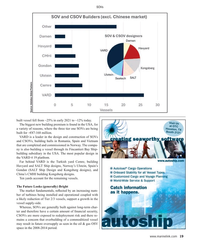 )
April 2024 - Maritime Reporter and Engineering News page: 19
)
April 2024 - Maritime Reporter and Engineering News page: 19compa- ny is also building a vessel through its Fincantieri Bay Ship- building subsidiary in the USA. The most popular design in the VARD 4 19 platfrom. Far behind VARD is the Turkish yard Cemre, building Havyard and SALT Ship designs, Norway’s Ulstein, Spain’s Gondan (SALT Ship Design and Kongsberg designs)
-
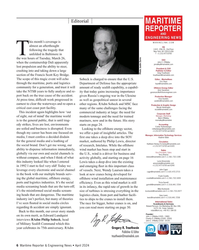 )
April 2024 - Maritime Reporter and Engineering News page: 6
)
April 2024 - Maritime Reporter and Engineering News page: 6Editorial MARITIME REPORTER AND ENGINEERING NEWS his month’s coverage is M A R I N E L I N K . C O M almost an afterthought HQ 118 E. 25th St., 2nd Floor following the tragedy that New York, NY 10010 USA T +1.212.477.6700 Tunfolded in Baltimore in the wee hours of Tuesday, March 26, CEO John C.
-
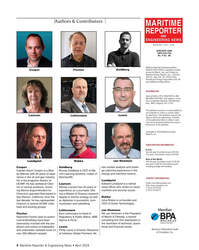 )
April 2024 - Maritime Reporter and Engineering News page: 4
)
April 2024 - Maritime Reporter and Engineering News page: 4Authors & Contributors MARITIME REPORTER AND ENGINEERING NEWS M A R I N E L I N K . C O M ISSN-0025-3448 USPS-016-750 No. 4 Vol. 86 Maritime Reporter/Engineering News (ISSN # 0025-3448) is published monthly Cooper Fischer Goldberg except for March, July, and October by Maritime Activity Reports, Inc.
-
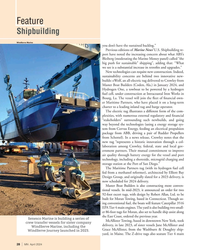 )
April 2024 - Marine News page: 28
)
April 2024 - Marine News page: 28Feature Shipbuilding WindServe Marine you don’t have the sustained backlog.” Previous editions of Marine News’ U.S. Shipbuilding re- port have noted the increasing concern about what ABS’s Bleiberg (moderating the Marine Money panel) called “the big push for sustainable” shipping”, adding that: “What we
-
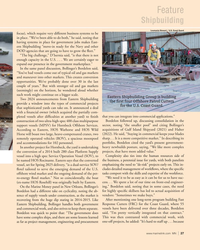 )
April 2024 - Marine News page: 27
)
April 2024 - Marine News page: 27integrated on that contract.” have some complex ships, and there are some lessons learned This was then contrasted with commercial work, with as far as project management, engineering and procurement one-off projects, he added: “It’s hard to staff up . . . because www.marinelink.com MN 27
-
 )
February 2024 - Maritime Reporter and Engineering News page: 36
)
February 2024 - Maritime Reporter and Engineering News page: 36intelligent energy Payback time for ABB’s PTI/PTO system is ? ve years at management system, along with electrically powered machin- current fuel prices (far less for new fuels). Michael D. Chris- ery and an optimized hull and cargo design, the company’s two tensen, VP Global Sales, Dry Cargo Vessels at
-
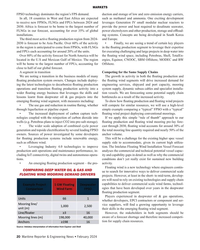 )
February 2024 - Maritime Reporter and Engineering News page: 20
)
February 2024 - Maritime Reporter and Engineering News page: 20, at least in the short- to mid-term, develop- ers will need to rely on existing technologies and supply chain capabilities to deliver commercial scale wind farms, technol- ogies that have been developed over years in the deepwater ? oating production segment. Players experienced in deepwater oil & gas operations
-
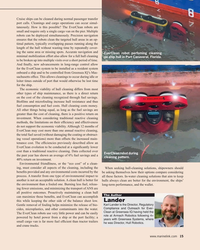 )
February 2024 - Maritime Reporter and Engineering News page: 15
)
February 2024 - Maritime Reporter and Engineering News page: 15role at Armach Robotics following 4+ powered by hotel power from a ship or the port facility; a years with Greensea Systems, where small cargo van is far more fuel ef? cient than tractor trailers he was Director, Hull Robotics. and crane trucks. www.marinelink.com 15 MR #2 (1-17).indd 15 2/6/2024
-
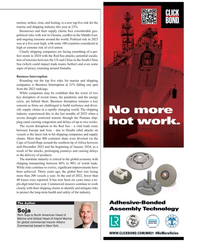 )
February 2024 - Maritime Reporter and Engineering News page: 13
)
February 2024 - Maritime Reporter and Engineering News page: 13motion, strikes, riots, and looting, is a new top ? ve risk for the marine and shipping industry this year at 23%. Businesses and their supply chains face considerable geo- political risks with war in Ukraine, con? ict in the Middle East, and ongoing tensions around the world. Political risk in 2023
-
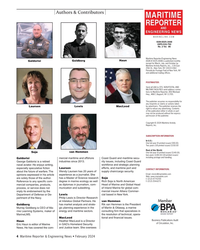 )
February 2024 - Maritime Reporter and Engineering News page: 4
)
February 2024 - Maritime Reporter and Engineering News page: 4, workforce and strategic planning especially speculative ? ction Laursen efforts, and maritime port and CONTACT INFORMATION: about the future of warfare. The Wendy Laursen has 20 years of supply chain/cargo security. Email: [email protected] opinions expressed in his article experience as a
-
 )
February 2024 - Marine News page: 36
)
February 2024 - Marine News page: 36Feature Marine Simulation Pioneering regulatory change Without simulation, opportunities to train on marine evacuation systems are few and far between, basically only Virtual Marine’s impact extends beyond technology de- coming along when the system becomes outdated and velopment. The company has played
-
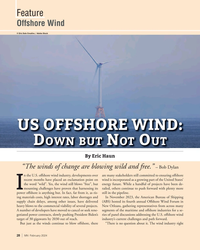 )
February 2024 - Marine News page: 28
)
February 2024 - Marine News page: 28challenges have proven that harnessing its railed, others continue to push forward with plenty more I power offshore is anything but. In fact, far from it, as ris- still in the pipeline. ing materials costs, high interest rates, labor shortages and In November 2023, the American Bureau of Shipping
-
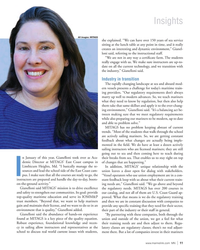 )
February 2024 - Marine News page: 11
)
February 2024 - Marine News page: 11it really creates an interesting and dynamic environment,” Gianel- loni said, referring to the instructional staff. “We are not in any way a certi? cate farm. The students really engage with us. We make sure instructors are up-to- date on all the current technology, and we transition with the industry
-
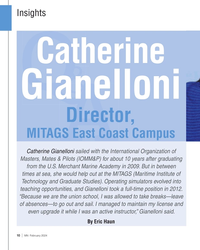 )
February 2024 - Marine News page: 10
)
February 2024 - Marine News page: 10Insights Catherine QQQQQQQQQAAA & Gianelloni Director, MITAGS East Coast Campus Catherine Gianelloni sailed with the International Organization of Masters, Mates & Pilots (IOMM&P) for about 10 years after graduating from the U.S. Merchant Marine Academy in 2009. But in between times at sea, she would
-
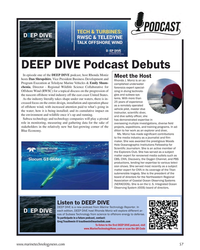 )
January 2024 - Marine Technology Reporter page: 57
)
January 2024 - Marine Technology Reporter page: 57DEEP DIVE Podcast Debuts In episode one of the DEEP DIVE podcast, host Rhonda Moniz Meet the Host hosts Dan Shropshire, Vice President Business Development and Rhonda J. Moniz is an ac- Program Execution at Teledyne Marine Vehicles & Emily Shum- complished underwater chenia, Director - Regional Wildlife
-
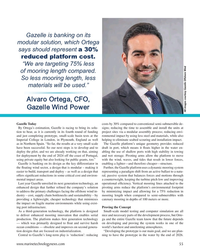 )
January 2024 - Marine Technology Reporter page: 55
)
January 2024 - Marine Technology Reporter page: 55also Imperial College in London, in Plymouth, England as well helping to eliminate seabed scouring and installation impact. as in Northern Spain. “So far, the results at a very small scale The Gazelle platform’s unique geometry provides reduced have been successful. So our next steps is to develop and
-
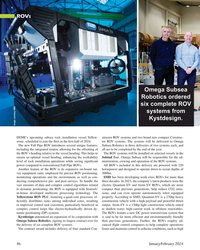 )
January 2024 - Marine Technology Reporter page: 46
)
January 2024 - Marine Technology Reporter page: 46positioning (DP) systems The ROVs feature a new DC power transmission system that Kystdesign announced an expansion of its cooperation with is said to be far more ef? cient and environmentally friendly Omega Subsea Robotics, signing its largest contract ever for than previous generations. Further, the ROVs
